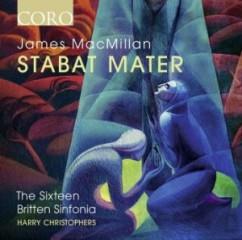James MacMillan - Stabat Mater (2017)
James MacMillan - Stabat Mater (2017)

PLAINSONG 1.Stabat mater 4:56 SIR JAMES MACMILLAN - Stabat Mater 2.Stabat mater dolorosa 14:48 3.Quis non posset contristari 13:13 4.Sancta mater, istud agas 11:32 5.Fac, ut portem Christi mortem 15:15 The Sixteen Britten Sinfonia Harry Christophers – conductor
Few living composers communicate with the emotional directness of Sir James MacMillan, and performances of his new Stabat mater received rave reviews. The Sixteen gave the world premiere of this work at a series of concerts in October 2016 as well as recording the work for their own record label, CORO. For MacMillan, 'beauty is at the heart of our Christian faith' and the Stabat mater is sure to be profoundly shaped by his beliefs. But this is a work with deep roots and a universal message, a celebration of both tradition and radical renewal. --- thesixteenshop.com
Composers across the generations have been attracted to set the beautiful and sad 13th-century Stabat Mater text, the Crucifixion seen through a mother’s grief, Mary weeping by the cross. Sir James Macmillan has taken up the challenge and has composed a moving, profound and startling interpretation for The Sixteen to perform, first heard at the Barbican last autumn with the Britten Sinfonia and now receiving its Scottish première with the same choral forces accompanied by the strings of the Scottish Chamber Orchestra. At an hour long, it is a major work, and arriving in Edinburgh and Glasgow in the middle of Lent, both concerts have been packed with audiences keen to experience MacMillan’s latest composition on the Crucifixion, conducted by Harry Christophers.
At a standing-room only pre performance talk with the composer, MacMillan explained this work was not written for the Liturgy, but the concert hall, following a long tradition of religious music. Composing the work specifically for The Sixteen (26 singers in this concert), he sees their early music sound as critical in setting the monochromatic tone palette of the choir and strings. MacMillan divided the 20-verse text into four equal movements, with many string interludes and singers from within the choir taking solos. MacMillan explained that his use of three high tenors was chosen to deliberately mirror the vocal colour of the Jewish Cantor or Muslim Muezzin, reflecting the location of the Crucifixion.
The sheer density of MacMillan’s writing makes it a challenge for the ear to take in all of the detail of what’s going on, but there is no question what we heard at this concert was a masterpiece both for strings and singers, immensely powerful telling the sorrowful story through grief, anger and tenderness. After an extended complex and angry angular string opening, The Sixteen took up the tone ranging from almost operatic (sky high soprano) to words being literally shouted out. A terrifying clash of glissandos, the whole choir sliding down to meet the strings rising upwards was one of several heart-stopping moments, at other times, the double basses set up a shimmering discordant rumble of death, and the lower strings creating a carpet of sound for the singers, at times almost in plainchant over a bass drone. There was lots of energetic solo work for the string section leaders and front desks, excitingly defiant and overlapping but suddenly tender, a violin solo soft like the watery rays of sunlight trying to break through the gloom. Visceral strident choral singing in the third movement Sancta Mater, istud agas bookended the deeply grief-stricken three high solo tenors. More beauty from plangent cellos contrasted fierce choral passages, before this complicated but utterly spellbinding work ended on simple Amens for the upper voices. An astonishing and intense journey for performers and audience, you could almost reach out and touch the concentration.
Earlier, we heard Macmillan’s orchestral showpiece Tryst, originally composed for the St Magnus Festival in Orkney almost thirty years ago and inspired by a poem of the same name by William Soutar. Macmillan conducted the orchestra, which danced through the themes, clarinets wailing, horns and trumpets holding noisy conversations over held string chords. With scoring including a bass clarinet and double bassoon, the woodwind sounded almost like the wheeze of an accordion at times. Quieter passages were illuminated by ghostly wind chimes and bell tree. Lots of aggressive angular interplay with string timpani interjections and ending with an extraordinary fierce musical sequence looped round the first and second violins with brass interludes. I was reminded of Bernstein at times when the music took a bluesy turn. Macmillan says that returning to his older pieces is similar to the mixed feelings experienced when re-reading youthful letters, but the infectious confidence of this performance from conductor and players spilled across into the hall banishing any wistful thoughts.
A major new work in the presence of the composer, in his home patch delivered by the wonderful Sixteen made this a specially memorable event. ---David Smythe, bachtrack.com
download (mp3 @320 kbs):
yandex 4shared mega mediafire uloz.to cloudmailru gett








